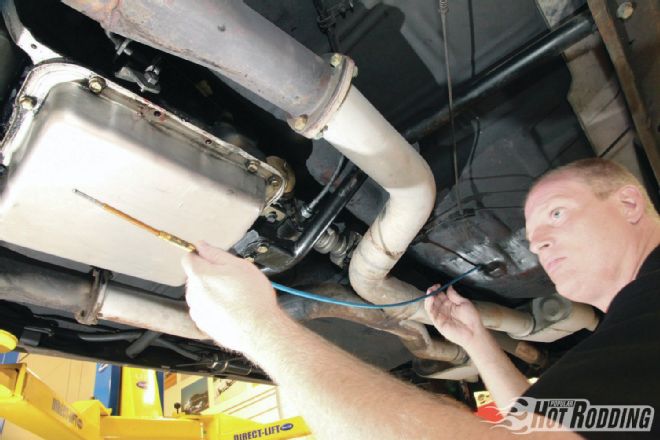
Tell us if this has ever happened to you: You pull away from the light, wait a moment, then stomp the gas. Right when you're expecting the rpm to soar and the g-force to push you back in the seat, the trans makes a perfect upshift (or two!)—right at 4,000 rpm. In another scenario, you're on the highway behind a slow loser, and you see a break in traffic to pass. You floor it, the engine lugs for an eternity, then begrudgingly gives up one gear instead of the two gears you needed yesterday. To add insult to injury, it quickly upshifts back into overdrive once you get in the passing lane. Ugh. Who's the loser now?
Those tools of convenience we call automatic transmissions have made our driving easy ever since the first Hydramatic two-speed was bolted to an Oldsmobile back in 1939, but as we see in the examples above, they often put performance users at a disadvantage when the chips are down. Now that we've got electronically controlled transmissions like the 4L65, 4L80, 6R80, and the 6L80, it's simply a matter of swapping out your old faithful Turbo 400, C4, AOD, or 700-R4, and bolting in a late-model multi-gear wonder. The cost of doing that, however, can be prohibitive. So is there another answer?
If we face facts, it's likely that you've already spent good money on a transmission you'd otherwise like to keep. Take for instance the four-speed automatic overdrive 700-R4 in Project Laguna. It's a perfect match for the 622hp solid-roller 427ci small-block Chevy in the car, and the 3.73-geared 10-bolt out back. Our trans—which can handle well over 700 hp and has the perfect torque converter already—no need to start from scratch. All we wanted was control over the shifts, so when Powertrain Control Solutions (PCS) told us they had a perfect solution for our powertrain, we asked two questions: How well does it work, and how much is it?
PCS makes the GSM-5000, which basically shifts your existing transmission by brute force through a built-in shift cable on the box. Once programmed, it knows exactly where to find each gear on the transmission within thousandths of an inch, no matter what kind of trans it is. It could be a C6, Powerglide, 727 TorqueFlite, AOD, Turbo 400, or a 700-R4 like ours. It just doesn't care—it could be the trans on your riding mower. You tell it how many gears there are and where they can be found, and let it eat. Better yet, the trans remains untouched internally throughout the process. Getting into the basic push-button version isn't cheap at $1,149, but it's way less expensive (and easier) than swapping your trans and converter for a more expensive electronic trans, converter, and transmission control module. This is way cheaper than that, not to mention more fun. The GSM-5000 will allow you to punch away at the gears sequentially using the push-button controller, holding the engine up to its sweet spot any time you wish. A standard set of "PRND" buttons allows Clark Kent operation for when you're not wishing to deal out the thunder. (Of course, if you'd rather go the high-tech electronically controlled route, PCS has you covered with a multitude of products, including its Simple Shift electronic controller, which takes the computer science degree out of electronically controlled transmissions.)
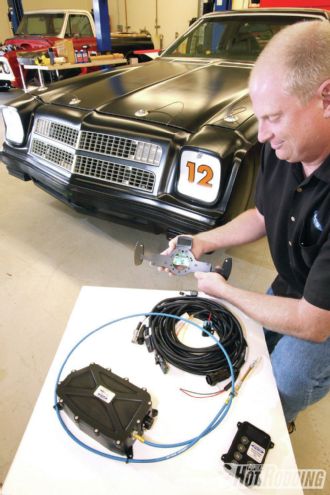 1. Powertrain Control Solutions (PCS) can convert any automatic transmission to push-button operation with its GSM-5000 kit ($1,149), but it’s the optional wireless paddle shifter (PS-5001, $425) that got our blood pumping for use on PHR’s Project Laguna.
1. Powertrain Control Solutions (PCS) can convert any automatic transmission to push-button operation with its GSM-5000 kit ($1,149), but it’s the optional wireless paddle shifter (PS-5001, $425) that got our blood pumping for use on PHR’s Project Laguna.
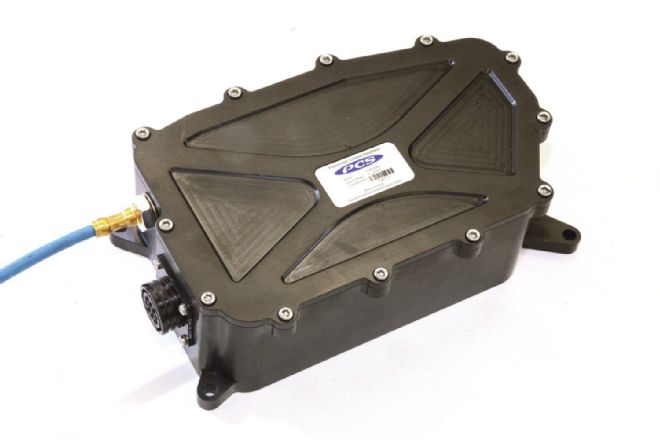 2. The heart of the GSM-5000 is the control box, which contains the electronic brain for the system, a high-powered servo attached to a Morse-type shifter cable, and a weatherproof harness connector, all wrapped in a mil-spec anodized aluminum housing.
2. The heart of the GSM-5000 is the control box, which contains the electronic brain for the system, a high-powered servo attached to a Morse-type shifter cable, and a weatherproof harness connector, all wrapped in a mil-spec anodized aluminum housing.
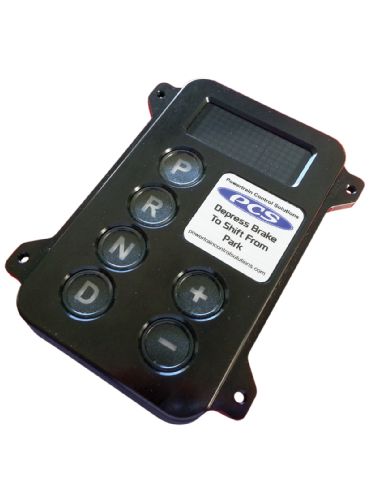 3. The push-button pad attaches to the GSM-5000 controller via a harness. The robust design is made of machined aluminum and includes an LED gearshift display and buttons that change color from red to blue when they are activated. It can be mounted anywhere in the cabin within arm’s reach.
3. The push-button pad attaches to the GSM-5000 controller via a harness. The robust design is made of machined aluminum and includes an LED gearshift display and buttons that change color from red to blue when they are activated. It can be mounted anywhere in the cabin within arm’s reach.
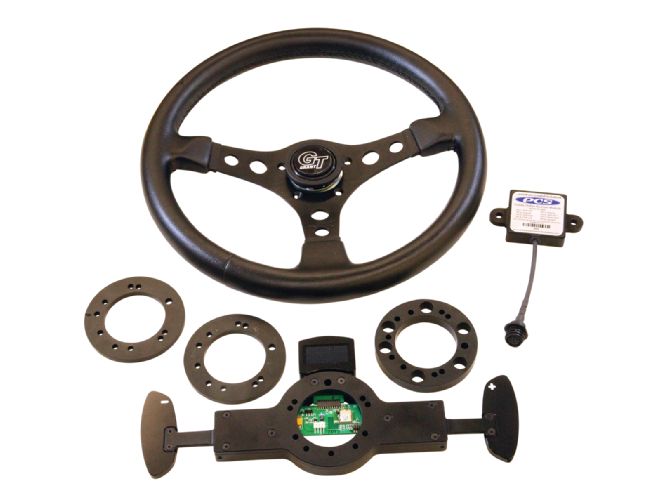 4. The push-button shifter on the GSM-5000 is nice, but the PS-5001 paddle shifter option is what brought us to the party. It includes the paddle shifter assembly (left paddle is downshift, right is upshift), a set of black anodized billet spacers, the wireless receiver module, and all necessary harnesses and fasteners (not shown). The 14-inch Grant GT No. 774 steering wheel was not included.
4. The push-button shifter on the GSM-5000 is nice, but the PS-5001 paddle shifter option is what brought us to the party. It includes the paddle shifter assembly (left paddle is downshift, right is upshift), a set of black anodized billet spacers, the wireless receiver module, and all necessary harnesses and fasteners (not shown). The 14-inch Grant GT No. 774 steering wheel was not included.
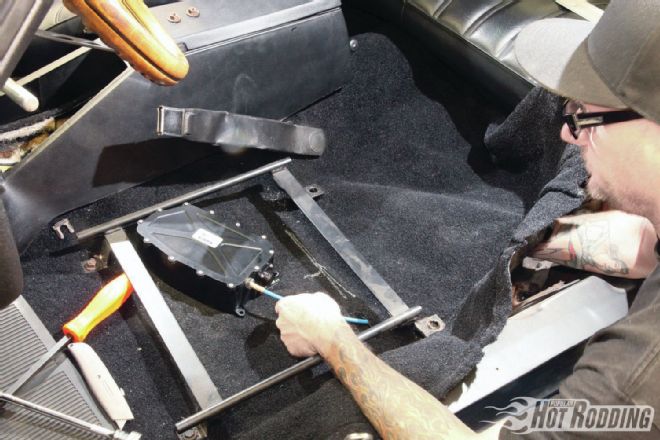 5. The first job is to find the right location for the GSM-5000 control box. The shift cable must not bind or be folded in any way, but can be curved in a gentle arc. The end of the cable needs to terminate at the shift select lever on the side of the transmission. Here, a slit is cut in the carpet, and a hole was drilled for the cable in the floor near the trans tunnel. Next, the electronic harness is attached, and 12V power is connected. The harness will be hidden once the shift detents are programmed and the final position of the button pad is established.
5. The first job is to find the right location for the GSM-5000 control box. The shift cable must not bind or be folded in any way, but can be curved in a gentle arc. The end of the cable needs to terminate at the shift select lever on the side of the transmission. Here, a slit is cut in the carpet, and a hole was drilled for the cable in the floor near the trans tunnel. Next, the electronic harness is attached, and 12V power is connected. The harness will be hidden once the shift detents are programmed and the final position of the button pad is established.
 6. On the bottom side, Jay Rohrback of PCS (also a major Laguna fanatic!) showed us how the cable route is adjusted while the control box position is finalized up top. Once the cable is right, the box can be secured to the floor or chassis. Note that the stock shifter and shift cable were removed prior to the start of the installation.
6. On the bottom side, Jay Rohrback of PCS (also a major Laguna fanatic!) showed us how the cable route is adjusted while the control box position is finalized up top. Once the cable is right, the box can be secured to the floor or chassis. Note that the stock shifter and shift cable were removed prior to the start of the installation.
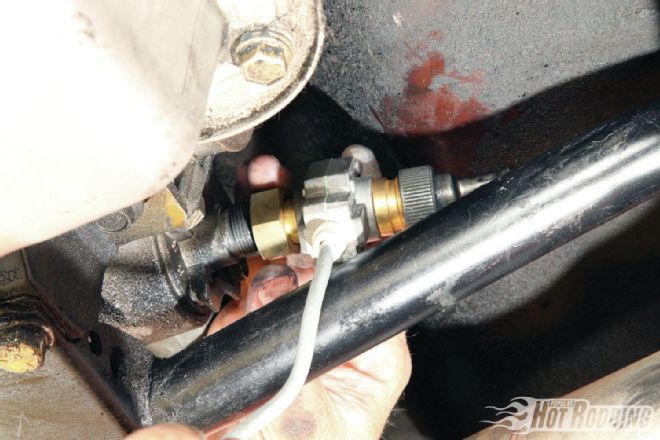 7. PCS includes an electronic speed sensor, which we attached to the speedo cable output on our 700-R4. Once screwed in, the speedo cable goes on the other end, and the electronic harness is attached to the GSM-5000. The sensor is needed to inhibit shifting into Park or Reverse at speed.
7. PCS includes an electronic speed sensor, which we attached to the speedo cable output on our 700-R4. Once screwed in, the speedo cable goes on the other end, and the electronic harness is attached to the GSM-5000. The sensor is needed to inhibit shifting into Park or Reverse at speed.
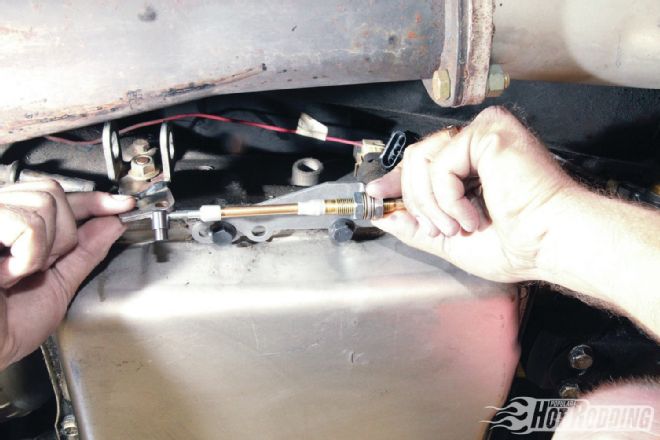 8. PCS includes a new cable mounting bracket and a shift lever that replace the stock pieces. These should be attached to the trans, but the cable should not yet be connected to the shift lever until after the transmission’s shift detent positions have been programmed into the GSM-5000 controller.
8. PCS includes a new cable mounting bracket and a shift lever that replace the stock pieces. These should be attached to the trans, but the cable should not yet be connected to the shift lever until after the transmission’s shift detent positions have been programmed into the GSM-5000 controller.
The product that we fell in love with, however, is the optional PS-5001 paddle shifter. For an extra $425, it turns your GSM-shifted street machine into a juggernaut, capable of commanding any gear instantly with a satisfying tug on its two black-anodized brushed aluminum paddles. (The left paddle is for downshifts, the right side is for upshifts.) The whole GSM-5000/PS-5001 enchilada reeks of covert military black-ops hardware; a bombproof control box with mil-spec connectors, strain-relief harnesses, weatherproof housings, precision CNC machining, non-reflective black anodizing, and easy-to-read LED displays not only look the part, they are the real thing. PCS designs and builds powertrain solutions under contract for the U.S. military, so real lives are at stake. This stuff has to work perfectly all the time, every time, and under every conceivable condition, or the wrong people can die. Oh yeah, and it's made in America. As far as we're concerned, every GSM-5000–equipped car deserves to have the PS-5001 paddle shifter option—it's just that fun.
In the months since we've installed ours, we've had the pleasure of pounding on the PCS system in a multitude of situations. I've got a C6 Corvette daily driver with the A6 trans and paddle shifters, and it has proven to be nowhere near as fun as the Laguna with the PCS paddle shifter. The 'Guna has another 220-plus horsepower over the Vette, but it's half a ton heavier, so its solid-roller small-block really needs the rpm to keep it in its happy place. In the past, we almost never experienced the sweet song of the .680-inch lift cam at concert volume. We had tinkered with the throttle-valve (TV) cable length and governor weights in the trans, but the bulletproof 700-R4 wasn't letting us play. Now that we can hold each gear to redline, we are blown away by all the fun we've been missing. Having the power on tap with a light squeeze of the hand is only part of it; hearing the redline snarl of the solid-roller small-block and Flowmaster 40s ricochet off concrete makes you feel like you're at Daytona or Talladega. Long, lurid burnouts without the trans burping out a Barney Fife upshift is icing on the cake.
So now you're wondering what's involved with putting one of these PCS paddle systems on your car. We invited Jay Rohrback of PCS to come out to the PHR tech center in Irvine, California, to show us what's involved. In our two-day wrenching mission, we captured it all in pics and video for the 23-minute video, and we deem this an easy weekend driveway/garage bolt-in. We still haven't figured out exactly where to put the push-button pad, but we're kind of glad we didn't mount it right away because we want to live with it for a while first. Otherwise, this was straightforward wrenching. The instructions were clear (even though we had the inventors in our midst!), and everything was included, with the exception of a five-bolt steering wheel. (We ordered a 14-inch Grant GT wheel from Summit for $95.) The hardest part was running through the shift detent calibration, whereby you move the cable in and out with the "+/-" buttons on the push-button controller.
We're still awestruck that such a simple mod like a paddle shifter can make such a huge difference in the personality of a car. We're finding new ways to terrorize import drivers every day, and it's only by the grace of God we haven't been locked up. Get this paddle shifter, and you too will be looking for excuses to drive your hot rod everywhere. Moreover, we are prepared for it to unlock a new world of fun on the dragstrip, autocross, and road course when the opportunity knocks. The sooner, the better!
More Video Online!
Want more details on the installation of the PCS shifter? Want to see it shifted in action on Project Laguna? You can catch all that by going to the video page, or clicking on YouTube.com/PopularHotRodding, and watching the video titled "PCS Paddle Shifter Installation."
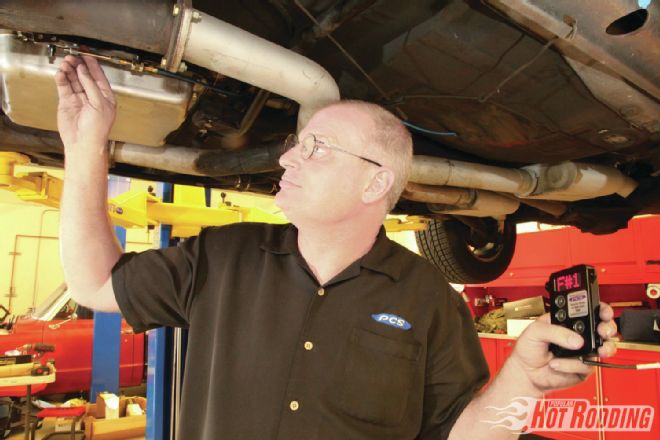 9. With the key on, follow the keypad prompts for selecting the number of forward gears, then programming the individual detent positions of the transmission lever into the GSM. (For the 700-R4, those are: P, R, N, D, 3, 2, 1.) This involves moving the +/- buttons to move the cable position until the pivot lug easily drops into the lever hole at that gear position.
9. With the key on, follow the keypad prompts for selecting the number of forward gears, then programming the individual detent positions of the transmission lever into the GSM. (For the 700-R4, those are: P, R, N, D, 3, 2, 1.) This involves moving the +/- buttons to move the cable position until the pivot lug easily drops into the lever hole at that gear position.
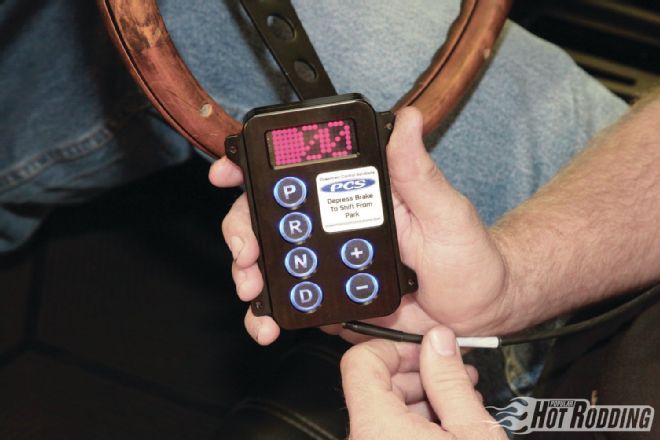 10. The final operation is verifying on the push-button control panel that the speed sensor is working. The manual will ask you to drive the car slowly while the display reads out vehicle speed. If it’s working, you will not be able to shift into “P” when the car is rolling faster than 1 mph, or “R” when the car is faster than 3 mph. If you’re just installing the push-button shifter only, you are finished!
10. The final operation is verifying on the push-button control panel that the speed sensor is working. The manual will ask you to drive the car slowly while the display reads out vehicle speed. If it’s working, you will not be able to shift into “P” when the car is rolling faster than 1 mph, or “R” when the car is faster than 3 mph. If you’re just installing the push-button shifter only, you are finished!
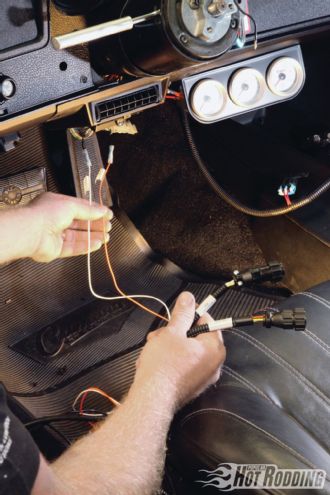 11. The PS-5001 paddle shift option is wireless, but it still needs power, which is hijacked from the factory horn button. The power from the horn will now feed the paddle shifter circuit board through a small three-wire harness added at the wheel hub. The horn will now be controlled wirelessly through the transmitter. The black harness on the right will attach to the wireless receiver (mounted under the dash) and run to the GSM-5000 under the driver seat.
11. The PS-5001 paddle shift option is wireless, but it still needs power, which is hijacked from the factory horn button. The power from the horn will now feed the paddle shifter circuit board through a small three-wire harness added at the wheel hub. The horn will now be controlled wirelessly through the transmitter. The black harness on the right will attach to the wireless receiver (mounted under the dash) and run to the GSM-5000 under the driver seat.
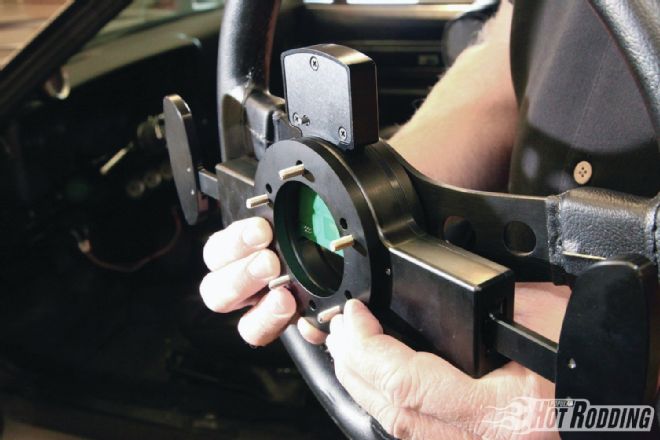 12. There is room for personalization on the PS-5001; some drivers prefer the paddles close to the wheel while others prefer them held off at a distance. PCS provides three spacers of different thickness for experimentation. We also bought a 14-inch wheel from Grant for $95, which matched the width of our paddles perfectly. Any five-, six-, or nine-bolt aftermarket wheel will work.
12. There is room for personalization on the PS-5001; some drivers prefer the paddles close to the wheel while others prefer them held off at a distance. PCS provides three spacers of different thickness for experimentation. We also bought a 14-inch wheel from Grant for $95, which matched the width of our paddles perfectly. Any five-, six-, or nine-bolt aftermarket wheel will work.
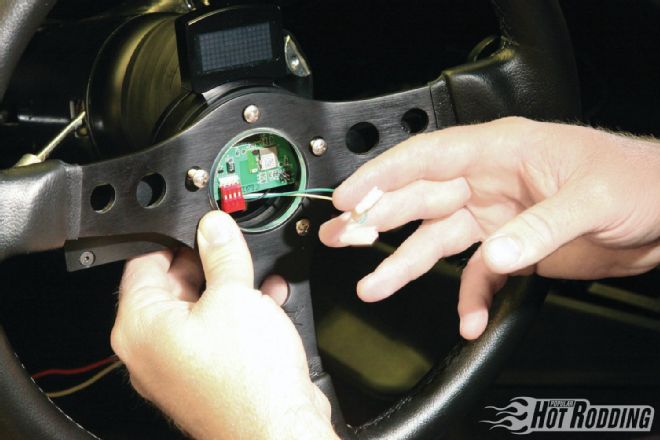 13. This small harness attaches to the old horn power wire and plugs into the paddle shifter circuit board via a small four-pin connector. Make sure not to bend the pins, a gentle touch works best. The last two spade connectors connect to the horn button and ground.
13. This small harness attaches to the old horn power wire and plugs into the paddle shifter circuit board via a small four-pin connector. Make sure not to bend the pins, a gentle touch works best. The last two spade connectors connect to the horn button and ground.
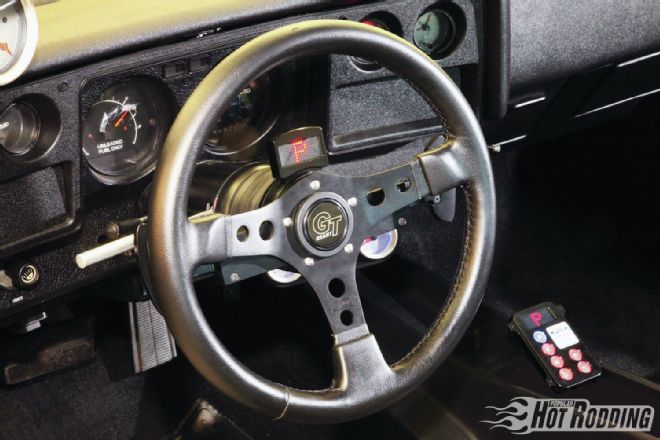 14. You now have total control over your gearshifts via attractive and comfortable steering wheel paddles! We now can keep the high-winding small-block right in the rev range we want without the trans or TV cable playing games with us. The GSM shifts instantaneously, but if we just leave it in “4” (the same as “D”) the trans goes about its business automatically just like it always has. That’s a win-win! Note how the LED display always reads the current gear in bold, bright red type.
14. You now have total control over your gearshifts via attractive and comfortable steering wheel paddles! We now can keep the high-winding small-block right in the rev range we want without the trans or TV cable playing games with us. The GSM shifts instantaneously, but if we just leave it in “4” (the same as “D”) the trans goes about its business automatically just like it always has. That’s a win-win! Note how the LED display always reads the current gear in bold, bright red type.